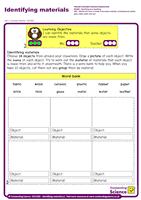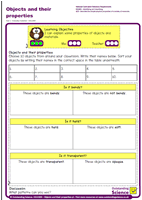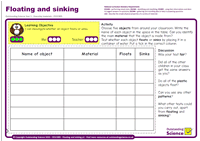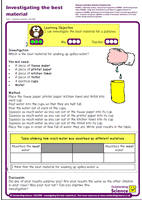

I can tell the difference between an object and a material.
Children learn about the difference between objects and materials. They use a word bank to select the correct object and material for 8 pictures.
I can identify the different materials from which an object is made.
Pupils examine 8 different classroom objects and identify the materials from which they are made, recording their findings in a frequency table. They use this data to create a pictogram using the writing frame and symbols provided. Pupils discuss why some objects are made from more than one material.

2 pages
I can name some everyday materials.
Children use a word bank to identify the material that 14 different objects are made from.

3 pages
I can identify the materials that some objects are made from.
Children choose 18 objects from around the classroom. They draw a picture, name the object and identify the material. They cut and sort the objects by material.

2 pages
I can explain some properties of objects and materials.
Children choose 10 objects from around the classroom. They sort them according to their properties - bendy/not bendy, hard/soft, transparent/opaque.

2 pages
I can investigate whether an object floats or sinks.
Children carry out an investigation into whether 5 objects from around the classroom float or sink. They record their results on a simple table.

1 page
I can group objects and materials by their properties.
Children work with a partner. They use 9 challenge cards to sort around 10 objects from around the classroom.

1 page
I can choose a good material for a purpose.
Children use a word bank to think of the best material to use in 8 different situations. They draw a picture of each object, and identify the material and its desirable properties.

2 pages
I can investigate the best material for a purpose.
Children carry out an investigation to find out which is the most absorbent of 4 materials. They use a table to order their results and use them to answer the question.

1 page